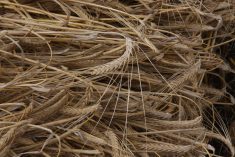Federal and provincial statisticians have compiled their year-end lists of production estimates for almost every crop from spring wheat to sunflower seed.
Noticeably absent from those reports is an estimate of Canada’s organic grain production.
The only source for that kind of information is an annual survey of certifiers conducted by Canadian Organic Growers, a national education and networking organization.
But results from the survey will not be available for a few months and it only estimates seeded acreage, not production volumes. So all there is to go on is anecdotal evidence, which suggests production in 2004 was way up, mirroring what happened in conventional agriculture.
Read Also

Vegetable oil stocks are expected to tighten this year
Global vegetable oil stocks are forecast to tighten in the 2025-26 crop year, this should bode well for canola demand.
“There was a tremendous upswing in supply,” said Mark Gimby, grain buyer for Growers International Organic Sales.
That is largely because grain supply in the previous two years was significantly reduced by drought, he said.
But according to Wally Hamm, western manager for OCPP/Pro-Cert Canada Inc., one of the country’s largest certification bodies, there is another reason behind the increase in production volumes.
“I would say that acreage is going up.”
That assertion flies in the face of what Canadian Organic Growers researcher Ann Macey unveiled in her 2003 industry survey, which showed the number of organic producers is tapering off after a period of rapid growth in the late 1990s and the early part of this decade.
Nationally, it has slipped to 3,134 producers in 2003 from a high of 3,236 in 2001.
The story is similar in Saskatchewan, which is home to one-third of the country’s certified growers and 58 percent of its 966,482 organic acres. Producer numbers in that province fell nine percent in 2003 to 1,049 certified growers from 1,150, according to the survey.
Prices lose shine
Macey said there are several explanations for why the industry appears to be losing steam. The most obvious one is that a lot of people came on board when they saw the attractive price premiums growers attained a few years ago. Those premiums are no longer as big.
Or it could just be a natural maturation process.
“All the enthusiastic ones are in there and it’s harder to reach some of the other people,” Macey said.
Another possible explanation why farmers haven’t stayed with the certification process is they are discouraged. Successive years of drought have prevented them from fully capitalizing on price premiums.
Hamm said the survey results don’t jibe with what he sees at OCPP/Pro-Cert, which certifies about half of the province’s growers.
He judges the state of the industry by the number of “dead files” in his office. This year he filled only one banker’s box with files of people no longer being certified compared to two or three boxes in previous years.
“I would say that the industry is growing.”
He estimated the number of certified producers in Saskatchewan is closer to 1,300 and many of the new recruits are large acreage farmers.
“For instance, this year we picked up an 18,000-acre farmer.”
Hamm said other certification bodies are also noticing interest from conventional farmers contemplating converting large tracts of land into organics.
“That isn’t necessarily good for the industry but those are the facts.”
Saskatchewan Agriculture organic specialist Blaine Recksiedler agreed the industry appears to be growing, but it may be “plateauing” or “catching up to itself.”
He pointed to an extensive survey of American organic food manufacturers conducted by the Nutrition Business Journal that estimates the growth rate of organic sales will taper off to 10 percent by 2010 from the current pace of 20 percent.
Hamm agreed that will likely be the case, but said those numbers can be misleading because as sales volumes get larger, percentage increases logically decline.

















